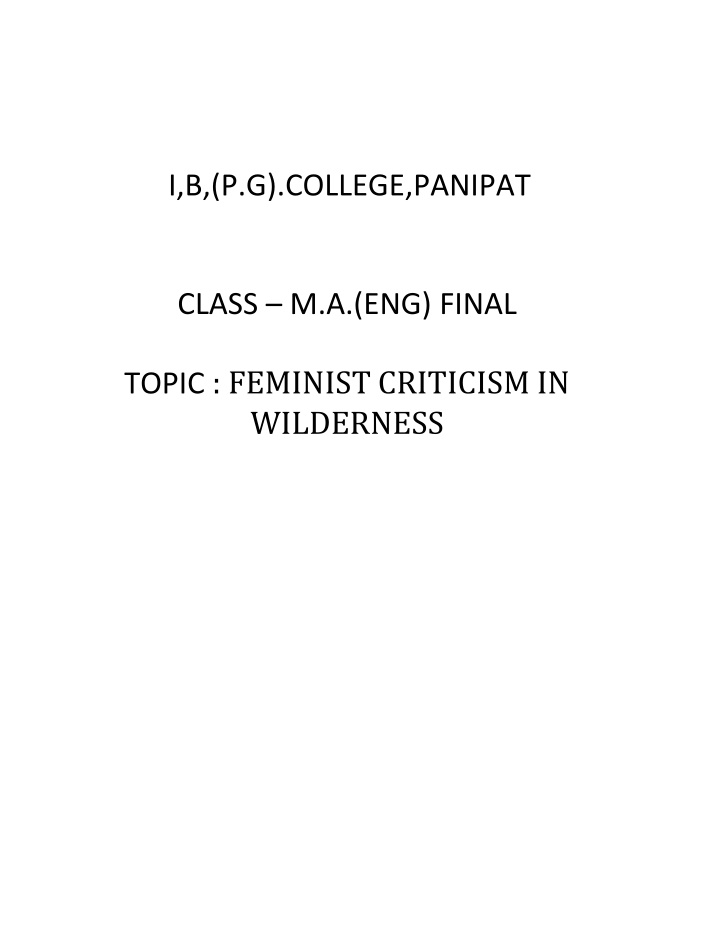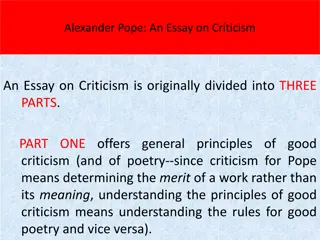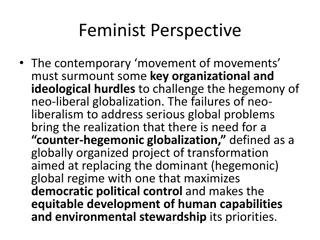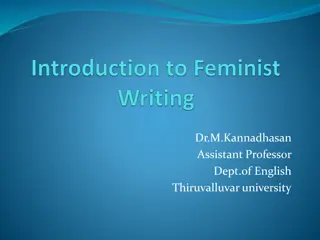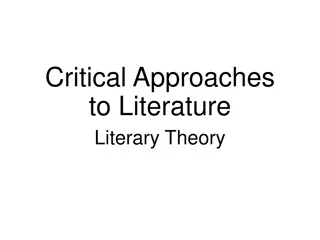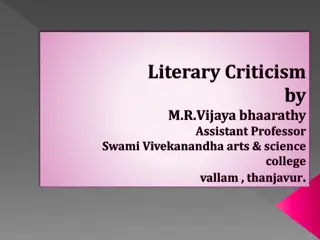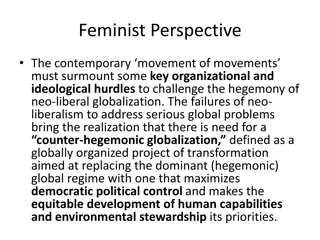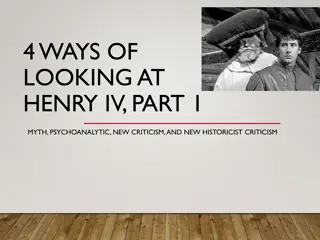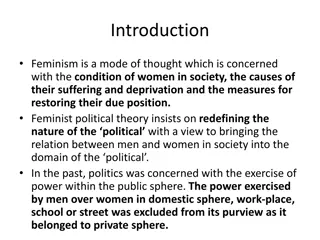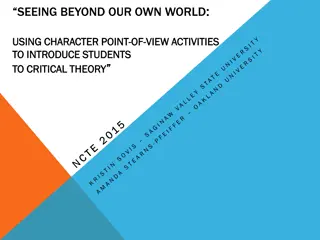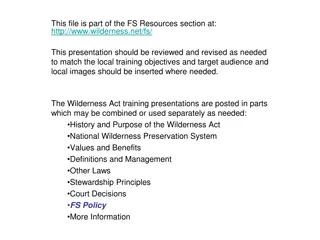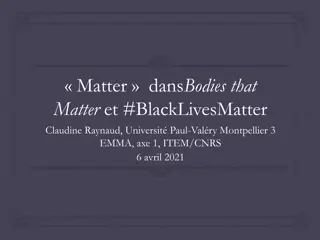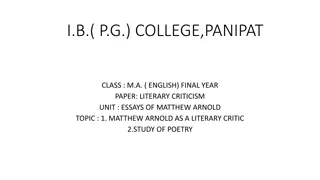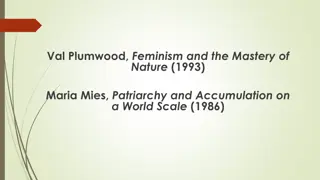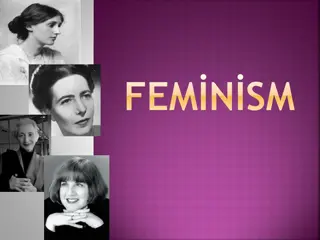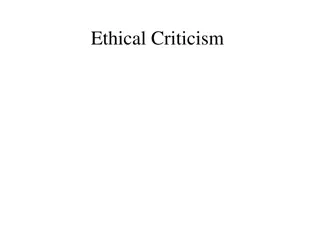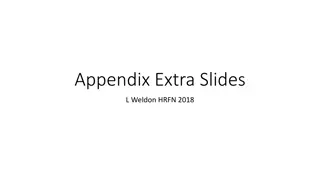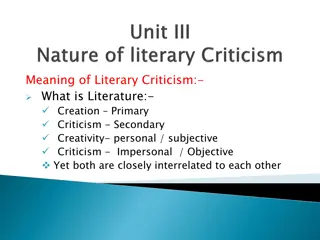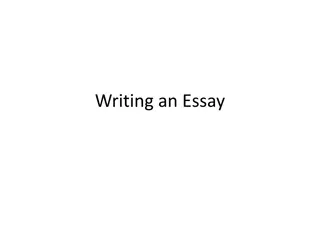Feminist Criticism in Wilderness: Analyzing Elaine Showalter's Essay
The essay by Elaine Showalter delves into feminist literary criticism, exploring its aims, challenges, and the perception of being in "wilderness." Showalter discusses the evolution of feminist criticism, the need for a solid theoretical framework, and the hurdles faced by feminist critics. She emphasizes the importance of pluralism in feminist critique and the transition from awakening to a phase of anxiety about feminist criticism's isolation. The journey to establish feminism in literary criticism has been both challenging and transformative.
Download Presentation

Please find below an Image/Link to download the presentation.
The content on the website is provided AS IS for your information and personal use only. It may not be sold, licensed, or shared on other websites without obtaining consent from the author.If you encounter any issues during the download, it is possible that the publisher has removed the file from their server.
You are allowed to download the files provided on this website for personal or commercial use, subject to the condition that they are used lawfully. All files are the property of their respective owners.
The content on the website is provided AS IS for your information and personal use only. It may not be sold, licensed, or shared on other websites without obtaining consent from the author.
E N D
Presentation Transcript
I,B,(P.G).COLLEGE,PANIPAT CLASS M.A.(ENG) FINAL TOPIC : FEMINIST CRITICISM IN WILDERNESS
SINCERE THANKS TO DR. AJAY KUMAR GARG PRINCIPAL ,I.B P.G COLLEGE,PANIPAT DR.MADHU SHARMA HOD ENGLISH DEPARTMENT
PRESENTED BY PREETI PAL ASSISTANT PROFESSOR IN ENGLISH
The essay by Elaine Showalter is an attempt to study the field of literary criticism from the feminist point of view. Showalter has tried to study the various aspects of feminist criticism while also pointing out the aims it should be trying to attain, the problems it faces and the reasons for these problems. The essay considers the fact that like feminist creative writers, feminist critics also face certain obstacles which have got highlighted after the rise of feminism. Showalter has tried to analyze in detail the belief that feminist criticism is in wilderness, which means, feminist critics are not capable enough to produce coherent speculations.
1. Pluralism and the Feminist Critique Showalter begins this essay by pointing out a dialogue by Carolyn Heilbrun and Catherine Stimpson. They had pointed out that two poles were identifiable in feminist literary criticism- one concentrating on the errors of the past and the other focus on the beauty of imagination. Both these aspects contribute in removing the effects of female servitude that has existed in the society since ages. She also quotes Matthew Arnold to state that criticism, as a process, has to pass through a stage of wilderness to reach at the desired standards. Then, taking support from Geoffrey Hartman s quote, she forwards the belief that all criticism, and not only feminist criticism, is in wilderness. Analyzing one of the reasons for this, so called, wilderness in feminist criticism, she clarifies that the reason is lack of an exclusive theoretical framework for feminist criticism. It is always seen in association with some other strategy and, therefore, fails to work consistently. For instance, feminist critics supporting Marxism treat feminist criticism differently than those opposing racism. An early obstacle in establishment of the above mentioned theoretical framework was the inability of many women to respond to the demand of openness required for the success of feminist criticism. In some aspects of society, women had been locked out and in some others they had been locked in. they were not allowed to participate in some aspects of social interaction and forced to participate in some others. Thus, some believed feminism to be equivalent to opposition to the establish canons.
Showalter says that what seemed to be a theoretical impasse was actually an evolutionary phase. During this stage, feminist criticism moved on from the stage of awakening to the stage marked by anxiety about the isolation of feminist criticism from a critical community . The definition of feminist criticism with reference to other feminist theories has been a serious debate and feminist critics have been unable to address this issue. They fail to understand the need to think beyond their own beliefs as well and to communicate with the systems they wish to change. Although feminist critics have communicated with these systems but the communication has been unclear being based entirely on the media of feminist critics. There are two modes of feminist criticism. Showalter calls the first one feminist reading or feminist critique . It is concerned to the reading of texts to understand the image of woman in literature and to work out the beliefs and stereotypes concerned to woman highlighted and publicized by literary texts. This is a mode of interpretation and has been quite influential in decoding the relationship of women to literature. Showalter points out that feminist criticism is revisionist being dependent on male creative theory, i.e. the creative works and interpretations produced on the basis of male experience. Feminist critics try to analyze and respond to male creative theory. This need to be changed to achieve feminist criticism that is women centred, independent and intellectually coherent .
2. Defining the Feminine: Gynocritics and the Womans Text It is well accepted that a woman s writing would always be feminine but defining feminine has always been a problem. The second mode of feminist criticism concentrates on this definition. It analyzes women as writers. It undertakes the study of history, styles, themes, genres, and structures of writing by women . It also studies in details the various aspects of female creativity and female literary tradition. Showalter has coined the term gynocritics for the specialized critical discourse that uses women s writings as its exclusive subject. However, identifying the unique elements of women s writings is again a problem. French Feminist Criticism has identified the influence of female body on female language and texts. However, the issue has been approached towards differently in different countries. Four basic models of difference are being used most commonly- biological, linguistic, psychoanalytic and cultural. Each of these models is like a school of gynocentric feminist criticism and has its own preferences for texts, methods and beliefs
3. Womens Writing and Womans Body It is one of the clearest statements of gender difference. Theories like that of better developed frontal lobes in case of males and of the use of 20 percent of creative energy for physiological functions in case of women have been used in the past to advocate the superiority of men over women. Many critics have associated the act of creation of text to the generative process which only male used to be considered capable of undertaking. The metaphor of literary paternity used to be associated to penis and, thus, to male. Showalter, however, associates it to womb comparing literary creativity to childbirth. The level and implication of the mention of anatomy in text by male and female writers, respectively, has also been different. However, study of biological imagery in women s writings could be helpful only when other factors affecting them are also kept in mind.
4. Womens Writing and Womens Language This concept analyzes if men and women use language differently while creating texts. It studies if factors like biology, social preferences and cultural beliefs could affect the language of a gender. It also considers the concept of the oppressor s language , the use of language by men to dominate women. For woman, the popular language could be like a foreign language which she is unable to be comfortable with. So, there is a call for development of separate feminine language. However, the irony is that even in communities where women are believed to have developed a separate language, their language is marked by secrecy. The differences in male and female speech in terms of speech, intonation and language use are the most obvious examples of difference in man s and woman s language. Feminist criticism should, most importantly, work for providing women an access to language so that a wide range of words is available to them. Language is sufficient enough to give expression to women s consciousness only if she is not denied access to all the resources of language.
5. Womens Writing and Womans Psyche This aspect deals with the connection between author s psyche and creative process in general. The difference in creative process in case of a male and a female is then studied on the basis of this connection. Various psychological theories have suggested that female is inferior in terms of creative capabilities. Critics have been trying to establish new principles of feminist psychoanalysis which would try to differentiate gender identities rather than following Freudian theories. Certain common emotional dimensions could be identified in texts of women writers belonging to different countries.
6. Womens Writing and Womens Culture The theory of culture as a factor affecting women s writing is inclusive of the theories of biology, language and psyche. The influence of all these factors is guided by the cultural situation of a woman. History has not included female experience. Thus, history is inadequate to understand women s experience. Woman s culture is not a sub-culture of main culture. They are part of general culture itself. If patriarchal society applies restraints on them, they transform it into complementarity. Thus, women experience duality of culture including general culture and women s culture. Women form muted group in society and men form dominant group . Ardener suggested a diagram with two circles representing these two groups respectively. All language of the dominant group is all acceptable language. So, the muted group has to follow the same language. The part of the circle representing the muted group which does not coincide with the other circle represents that part of women s life which has not found any expression in history. It represents the activities, experiences and feelings of women which are unknown to men. Since they do not form part of men s life, they do not get representation in history. This female zone is also known as wild zone since it is out of the range of dominant boundary. Women could not write on experiences belonging exclusively on the wild zone. They have to give representation to the dominant culture in their texts. There are other muted groups as well than women. For instance, literary identity of a black American poet is forced upon her by the trends of the dominant group.
Feminist critics try to identify the aspects of women writers which do not follow the trends established by the male writers. For instance, Woolf s works show tendencies other than those of modernism. However, these tendencies are visible in the sections which have so far been considered obscure or imperfect. Feminist critics should attempt thick description of women s writings. It is possible only when effect of gender and female literary tradition are considered among the various factors that affect the meaning of the text. Showalter concludes that the promised land or situation when there would be no difference in the texts written by man and woman could not be attained. Attainment of that situation should not be the aim of feminist critics.
